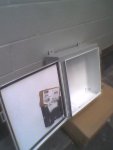Let's forget the catalog listings, where they simply might not mention every possible enclosure type. Let's also forget what we have 'heard,' or what manufacturers have said in their catalog summaries of different enclosure types. Instead, let's look at what NEMA says:
NEMA defines NEMA-3R as: Enclosures constructed for either indoor or outdoor use to provide a degree of protection to personnel against access to hazardous parts; to provide a degree of protection of the equipment inside the enclosure against ingress of solid foreign objects (falling dirt); to provide a degree of protection with respect to harmful effects on the equipment due to the ingress of water (rain, sleet, snow); and that will be undamaged by the external formation of ice on the enclosure.
NEMA defines NEMA-12 as: Enclosures constructed (without knockouts) for indoor use to provide a degree of protection to personnel against access to hazardous parts; to provide a degree of protection of the equipment inside the enclosure against ingress of solid foreign objects (falling dirt and circulating dust, lint, fibers, and flyings); and to provide a degree of protection with respect to harmful effects on the equipment due to the ingress of water (dripping and light splashing).
Now ... what does this mean in terms of testing?
"Indoor use" used to infer a different level of corrosion protection. This is no longer the case; all enclosures now face exactly the same corrosion tests, unless they are specifically rated for some particular environment (such as "marine.") Indoor and outdoor enclosures have the same exposure test.
Please note that the NEMA-12 definition makes no mention of oil, or 'oil tight,' or 'oil seepage.' It does mention 'light splashing.' I can categorically state that the rain test for NEMA-3R, and the implied drainage requirement, are far more severe than any 'light splashing.' From that regard, NEMA-3R exceeds NEMA-12 requirements.
This leaves us with the issue of knockouts. Since NEMA-3R requirements place all knockouts below any live parts, and require the enclosure to not retain 'excessive' water after the rain test, I have to wonder if this difference in the specification is a cause for concern- especially if there are no factory KO's left unused after installation. Or, if the KO's are replaced with gasketed plugs.
Now, some have made reference to NEMA-4, whose enclosures often look very much like NEMA-12 enclosures. Note that NEMA-4 has a test where a pressurised stream of water is directed at the enclosure from every angle. It's safe to say that an enclosure that will keep hose directed water out from any angle will also keep out 'light splashing' or falling rain.
My point is that one cannot simply adopt the small-minded, petty attitude of 'if the sticker doesn't say just the right things, then it won't do.' One must think, as well. Nor is it the responsibility of the customer to address your ignorance.
The same can apply in the opposite direction; for example, one would be obligated to require additional protection in certain circumstances. For example, even a stainless steel enclosure will corrode away in a sewage pit, while a 'not corrosion resistant' cast iron one will do just fine. Go figure!



